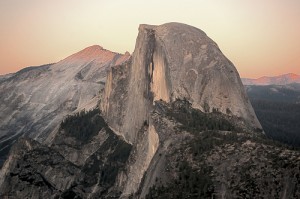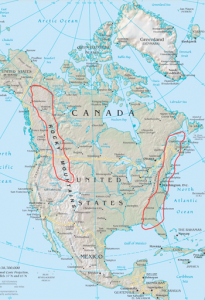I’m on a site tour, standing with a group of dedicated conservation advocates in a field just outside of Troy, Montana. It’s a truly unimpressive place. A nondescript forested ridge lies in the far distance, a couple of well-kept houses and not-so-well-kept shacks are strewn about in the near distance, I look down to see some nondescript scrub under our feet—and then there’s the rural highway behind me. A land trust official is talking about how we protected this place, how really exciting this is, how it constitutes a breakthrough for the region, how we should be really happy and proud, et cetera, et cetera. My mind drifts off…and in this case it’s to pornography. Yes, porn—but not the regular type. Rather, I’m a big fan of ecoporn. A sucker for it actually, can’t keep my eyes off it. And because we’re here in mid-March, it is very much on my mind since it’s been less than a week since I got around to that momentous annual decision: Which nature calendar to pin-up on my office wall for (what remains of) this year? It’s the same dilemma every twelve (or so) months, and as ever, I’m completely frustrated by the socially unacceptable practice of hanging multiple calendars in my office. Should I go with the Sierra Club’s calendar? World Wildlife Fund’s? The Nature Conservancy’s? Defenders of Wildlife’s? They are all so beautiful, so enticing, so…sexy. Yes, maybe some are more seductive or stimulating than others, but they’re all real good. To paraphrase one incisive and layered definition of ecoporn (see the note on sources below), it’s two-dimensional material that offers comfort to the viewer, that offers gratification without social cost, that satiates by providing objects for fantasy without making uncomfortable demands, and that will always be there, ideal, unblemished, and available. And just as women are trivialized by pornography, as another commentator put it, landscapes are trivialized by ecoporn: We make pilgrimage to the objects we have admired on calendars and trample the habitats of other species or exterminate them for their inconvenience to our viewing pleasure. In the process, our perceptions have been blunted and perverted, just like those of the readers of Playboy.

Is this harsh? Should we all be blushing at the sight of our nature wall calendars? I get the point of these critiques, and I accept that they are making a point that deserves serious and lasting consideration. Yet I know that when I gaze at, say, Ansel Adams’ stark portrait of Yosemite’s Half Dome, I’m not exactly saying to myself: “Yowza, what an awesome fantasy—and how great is it that it comes at no social cost!” Rather, I’m usually just thinking: “Wow.” Which is to say that I do not have the psychological, moral, or poetic insight that would allow me to say anything profound or game-changing regarding whether or not we should abhor ecoporn. I do, however, think there’s a parallel to be drawn here to historian William Cronon’s now (in)famous essay, “The Trouble with Wilderness.” That article drove many wilderness defenders nuts, and generated a tremendous debate within the conservation community over the role of wilderness—or the concept of wilderness—in environmental history. Cronon covers a lot of ground in that essay, but whatever one thinks of Cronon’s numerous arguments, there’s one on which all combatants in the debate could agree: viz., that wilderness should never be used as an excuse, conscious or unconscious, to allow for the degradation of the environments within which people live their daily lives. My wilderness advocate friends would say “no duh,” but I think it was a worthwhile point for Cronon to emphasize to disinterested lay readers (of which there may have been three or four). Similarly, whether or not one considers a glorious picture of the Grand Canyon or the Great Barrier Reef as constituting “ecoporn,” we should not let those pictures trick us into thinking that these are the only places worth protecting. That is, our innate and/or culturally induced attraction to the monumental and the spectacular may or may not be problematic, but whatever it is, we should not let it detract from our capacity to perceive the value—sometimes the extremely high value—in what may not be all that monumental or spectacular.

Which brings me back to this G-rated plot of land where I’m shuffling my feet, nodding my head in what I pray looks like sage agreement with whatever the land trust official is telling me about how important the place is. As it turns out, this is where grizzly bears cross the road to make their way from one relatively secure area to another, and we know this because of the many years of hard work by bear biologists, road ecologists, and the people and institutions who both financially and logistically support their work. The group I’m with at this particular time, the Yellowstone to Yukon Conservation Initiative, has ponied up a sizeable portion of the purchase price of the land, and looking around, it’s patently obvious that we aren’t spending all this money because you’d want a picture of this place on your wall. You might think we’re doing it because Y2Y hasn’t produced a calendar in a couple of years and we figured what the hell…but no, that’s not the case. Rather, it is due to our initial investment in conservation science that we know that this is the right place to focus our conservation action.

This all may seem a bit strange, particularly given that Yellowstone to Yukon bookends itself between two iconic names that resonate with Americans and Canadians (or, as the critics might put it, that Y2Y stretches between two XXX ecoporn studios). No doubt, from its origins Y2Y has been a conscious and deliberate approach to turning heads and focusing people’s attention. But here’s what’s so critical about the idea of Y2Y: those spectacular bookends highlight the connected character of what lies in between. As a conservation geography, Y2Y is vast; if you superimposed the outline of Y2Y on a map of the east coast, it would stretch from the Gulf of Mexico to Quebec’s Gaspé Peninusula. From its first conception, the rationale for Y2Y has largely focused on the needs of large animals that survive by moving across this enormous landscape, between the Greater Yellowstone Ecosystem and the Yukon. With the looming threat of climate change, that rationale has only become part of a more urgent emphasis on protecting the land; Y2Y and 18 other geographic case studies of large landscape conservation responses to climate change are highlighted in Climate and Conservation: Landscape and Seascape Science Planning and Action. So I try to put it all together. Here I am, a conservation supporter who originally got in this game at least partly due to an ecoporn addiction to the spectacularly monumental. Subsequent to that immersion into conservation, my latent conservationist ideals have been informed and enriched by the idea that we need to protect large landscapes. That knowledge in turn led me to get involved in one of the largest landscape efforts on the planet—viz., Yellowstone to Yukon. Finally, that involvement has brought me to this comparatively bland point on the map where we’re spending a lot of money to protect something the size of (and what, frankly, looks like) a cow pasture. And by making sure that this pasture doesn’t become ranchettes or gas stations, we are doing the critical work of protecting the continent’s wildlife. How strong is this causal chain? I’m not sure, but I’m not at the point where I can swear off ecoporn. To try to keep myself mindful, I have tacked up a picture of this plot of land next to this year’s calendar. It ain’t pretty, but the more I look at it, the more I like it. By the way, I went with The Wilderness Society’s calendar; it starts the year with a spectacular photo of Grand Tetons, and I can live with January showing for a little while—I never actually use the calendar anyways.
Source notes: The first definition for ecoporn comes from Lydia Millet’s High Country News article, “Die, baby harp seal! It's time for environmentalism to get ugly,” which was later reprinted in Utne Reader as “Ecoporn exposed.” The second comes from Jose Knighton’s essay, “Ecoporn and the manipulation of desire,” which was originally published in WildEarth (Spring 1993) and then reprinted in Wild earth: Wild ideas for a world out of balance (Milkweed 2002, edited by Tom Butler). It’s worth noting that the earliest reference to “ecoporn” I was able to find comes from the 1980 edited volume, The new environmental handbook, which contained an essay entitled “The new, improved ecopornography.” However, author Tom Turner used the term in reference to “image advertising” by large corporations—what we largely call “greenwashing” today. Maybe we should have left it at that.


